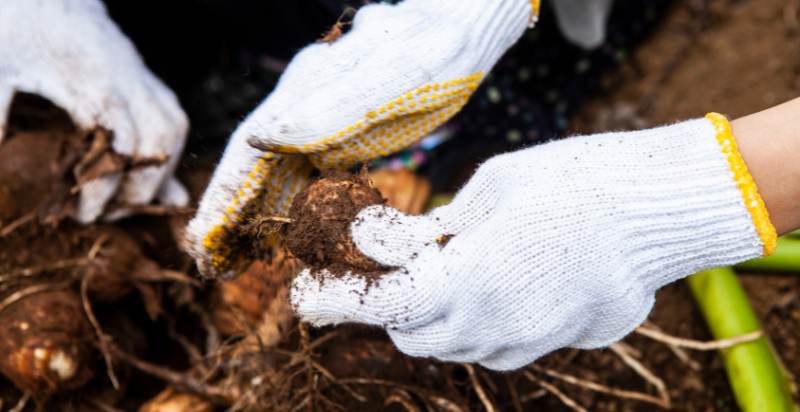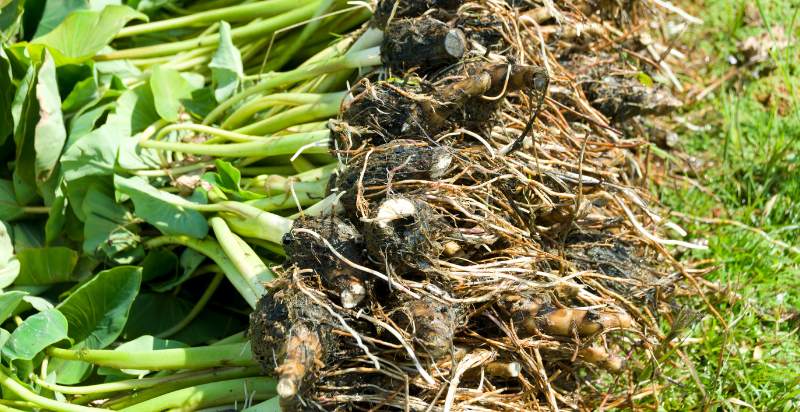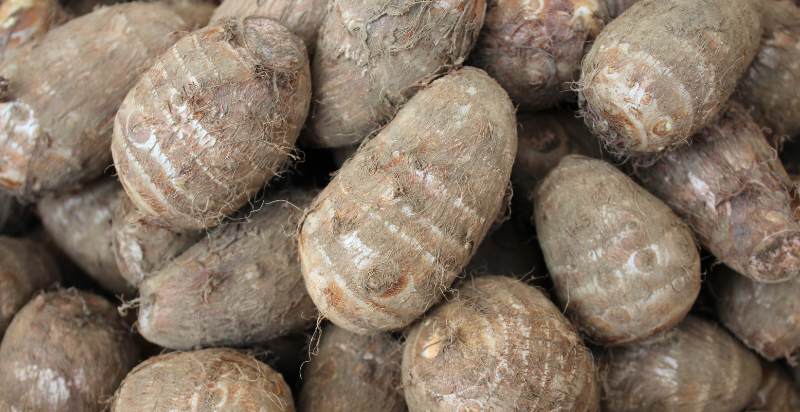Taro is a tropical, starchy root vegetable that has been part of the human diet for millennia. It is an important source of carbohydrates in many parts of the world and can be used to make poi, a traditional Hawaiian dish.
The plant is easy to grow and requires minimal care; however, there are certain steps you should take to ensure successful planting and harvesting. This article will provide information on how to successfully plant, grow, and harvest taro.
What is the Taro Plant?
Taro is a large, leafy plant that can grow up to three feet tall. It belongs to the Araceae family and produces many edible tubers. The leaves are heart-shaped and rough in texture, with a waxy coating on the lower surface. The fleshy, underground parts of the plant produce clusters of small roundish tubers and corms of taro roots. These have an earthy flavor when cooked, similar to potatoes.
Taro plants, also known as Colocasia esculenta, are widely cultivated root vegetables in tropical and subtropical regions worldwide. Originating from Southeast Asia, taro is now grown in many parts of Africa, Asia, Oceania, Latin America, and the Caribbean. Taro is an important dietary staple that has served as a major source of nutrition and income for centuries.
History And Origin Of Taro Plants:
Taro is an ancient crop that has been cultivated for thousands of years. It is believed to have originated in Southeast Asia and spread throughout the world’s tropical regions as early as 3,000 BC. The plant was a major source of nutrition in many parts of Africa, Asia, Oceania, Latin America, and the Caribbean by the time Europeans arrived in these areas.
Today, taro is mainly grown in Africa, India, and China but can be found worldwide wherever suitable growing conditions exist. In some countries such as Indonesia and Thailand, taro root is consumed daily as a staple food while in other countries it is considered more of a delicacy or used to supplement other dietary sources.
Varieties Of Taro Plants:
Taro comes in many different varieties, each with unique characteristics. Some of the most popular varieties include Chinese taro (Colocasia esculenta), Japanese taro (Arisaema sikokianum), and Indian taro (Amorphophallus paeoniifolius). Different varieties of taro root can vary significantly in color, shape, size, and flavor.
Some varieties are more commonly used for cooking, while others are better suited to ornamental use or plant propagation. The leaves of some varieties have a mild sweet taste that makes them ideal for salads or stir-fries.
Description and Growth Habits of Taro Plants:
Taro plants are herbaceous perennials with large heart-shaped leaves arising from the base of their underground stem or corm. The corm can weigh up to 9 lbs (4 kg), depending on the variety. It produces leafy stalks that can reach lengths of 6 ft (1.8 m), with each leaf measuring up to 18 in (45 cm) long and 12 in (30 cm) wide. Taro plants prefer warm climates, with plenty of rain and humidity.
Cultivation Of Taro Plants:
Taro can be grown in a variety of ways, from potted plants to large-scale commercial fields. Choosing well-draining soil with plenty of organic matter is important, as taro does not tolerate waterlogged conditions. The corms should be planted 2–3 ft (0.6–1 m) apart during the wet season, each covered by an inch or two of soil. After planting, the plants will take approximately four months to reach maturity and be ready for harvest. Taro also requires regular weeding and mulching to ensure optimal growth and yield.
Uses Of Taro Plants:
Taro root is a versatile vegetable that can be cooked in a variety of ways. It can be boiled, mashed, fried, or even eaten raw. The leaves can also be cooked and used as an ingredient in soups and stews.
Taro is often used to make flour, which is used to produce foods such as bread, cakes and noodles. The powder form of taro root is also used to make baby food or as an ingredient in many cosmetics products. In some parts of Africa, the starch from taro corms is used for making traditional beers and wines.
In addition to its culinary uses, taro has many medicinal properties that have been valued since ancient times. Studies have shown that taro extract has anti-inflammatory, antibacterial, and antioxidant properties that can benefit human health.
Taro is also widely cultivated as an ornamental plant in many parts of the world. The large, showy leaves make it a popular choice for both gardens and indoor decor.
Nutrition Of Taro Plant :
Taro root is rich in dietary fiber, antioxidants, vitamins, and minerals. It contains a good amount of vitamins C, E, and K and B vitamins thiamin and folate. Taro also provides calcium, magnesium, potassium, and phosphorus for healthy bones and teeth. The leaves are an excellent source of beta-carotene, a potent antioxidant that helps protect cells from damage caused by free radicals.
This nutrient-dense vegetable has recently become popular among health-conscious consumers looking for low-calorie food with high nutritional value. In addition to its numerous health benefits, taro root can also help reduce cholesterol levels in the body due to its high fiber content.
The taro plant is a nutritional powerhouse, offering numerous health benefits. Its kitchen versatility and aesthetic appeal make it an excellent choice for any garden. With proper cultivation, taro can be enjoyed year-round as a delicious and nutritious food or ornamental plant.
Health Benefits Of Taro Plant:
Taro root provides numerous health benefits. It is a good source of dietary fiber, which helps reduce cholesterol levels and maintain digestive health. Taro also contains antioxidants and vitamins that can help boost the immune system and fight inflammation. It is rich in calcium, magnesium, and potassium, essential for healthy bones and teeth. The leaves are packed with beta-carotene, an antioxidant that helps protect cells from damage caused by free radicals.
In addition to its nutritional value, taro root has many medicinal properties as well. Studies have shown that taro extract has powerful anti-inflammatory properties that can help relieve pain and swelling associated with arthritis or other inflammatory conditions. Taro is also a remedy for skin disorders such as eczema and psoriasis. Furthermore, recent studies have demonstrated that extracts from taro leaves have antibacterial properties and can help fight off bacterial infections.
Overall, taro is a nutrient-dense vegetable with numerous health benefits. It is an excellent choice for anyone looking to add more nutrition to their diet without adding too many calories. The versatility of this plant makes it easy to include in any meal and the attractive foliage makes it perfect for gardening or as an indoor decoration. With proper cultivation, taro can be harvested year-round and enjoyed as a delicious and nutritious food or ornamental plant.
How to Plant Taro Plants?
Taro is an incredibly versatile and nutritious root vegetable, which makes it a great addition to any kitchen garden. Planting taro is easy and takes minimal effort as long as you have the right conditions. Here’s how you can plant your taro:
Choosing Your Taro Plant :
When selecting taro plants for your garden or farm, picking specimens with healthy-looking leaves and stems is important. Avoid any plants with brown or yellow spots on the foliage as these could be signs of disease or pest infestation. Additionally, ensure the taro plants you choose are suited to your climate and soil type; some varieties may grow poorly in certain conditions.
Preparing the Soil :
When preparing the soil for planting, start digging down 10-12 inches and adding a layer of compost to the top 6 inches. This will provide nutrients for the plant’s root system and help it thrive. It is also important to check the pH levels of your soil before planting; taro prefers slightly acidic soils with a pH between 5.5 and 7.0. If needed, add lime or sulfur to adjust the pH levels accordingly.
Planting Your Taro :
To properly plant your taro, dig a large hole to accommodate its roots and covering it with soil. Ensure the tuber is planted with the upper surface slightly above ground level; this will help ensure it doesn’t get waterlogged. Water your taro after planting and keep the soil evenly moist throughout its growing season.
Planting taro can be done in several ways, all of which are relatively straightforward. The most popular way is to plant the corms or bulbs found in many nurseries or online.
- Place the corms in a container filled with potting soil, ensuring they are covered with two inches of soil. Plant them several inches apart and water them well after planting.
- Another option is to plant the corms directly into the ground, where taro plants will grow best in warm climates with at least three hours of full sun each day during their growing season. Dig a hole about six inches deep and place the corm inside, covering it completely with soil. Water it thoroughly and keep up regular watering for optimal growth afterward.
- You can also propagate your taro from cuttings taken from existing plants. Select a healthy stem and cut it off at the base with a sharp blade. Remove all the leaves, leaving just a few at the top of the cutting. Plant this in moist soil, cover it partially and keep it in indirect light until shoots appear from below the surface. When these shoots are about three inches long, you can then transplant them into their containers or directly into your garden.
- Finally, some varieties of taro may be propagated using just pieces of corms or tuberous roots that have been cut into two-inch sections and planted similarly as described in step one above.
No matter which method you use for planting taro, keep the soil consistently moist but not soggy, and fertilize the plants every few weeks with a balanced fertilizer. With proper care, you will soon have healthy taro plants that will yield beautiful foliage and delicious corms or tubers.
How To Care For Taro Plants?
Caring for a taro plant is relatively easy and does not require much special attention. The most important thing to remember is to keep the soil moist but not soggy, as too much water can lead to root rot.
Taro plants also need regular fertilization with a balanced fertilizer during their growing season, which should be done every two weeks. If you are planting your taro directly into your garden, ensure that it has plenty of space between other plants and receives several hours of sunlight each day.
Since taro is sensitive to cold temperatures, it’s best to bring any potted plants indoors during the winter months or cover them with mulch if they are planted outdoors. Regular pruning of the foliage is also recommended to keep the plant healthy and compact and encourage better flowering and fruiting.
With proper care, your taro plants will reward you with lush foliage and delicious tubers or corms that can be cooked in various ways. Enjoy!

Some Additional tips for Growing Taro Plants?
• Choose a spot in your garden or container that receives at least 6 hours of sunlight daily.
- Try to plant your taro in well-draining soil, as standing water can lead to root rot.
- To avoid nutrient deficiencies, fertilize your taro plants every 2 weeks during their growing season with a balanced fertilizer.
- If you are planting directly into the ground, space them enough, so they have plenty of air circulation and room to grow properly.
- Prune the foliage regularly to keep the plant neat and encourage better flowering and fruiting.
- Inspect your taro plants regularly for signs of pests or diseases and act as soon as possible.
- Finally, when it comes time to harvest, use a spade or shovel to carefully dig up the corms and store them in a cool and dry place immediately.
By following these tips and taking proper care of your taro plants, you should be able to enjoy a plentiful harvest of delicious corms. Enjoy!

Preventions From Pests and Diseases:
Taro plants can be susceptible to various pests and diseases, so it’s important to take measures to keep them healthy. The most common issues include aphids, mealybugs, whiteflies, thrips, and spider mites. These can all be treated with neem oil or insecticidal soap spray.
Diseases such as root rot, bacterial wilt, and fungus can also affect taro plants. Ensure the soil is well-drained and not too wet to prevent these issues. Ensure ample air circulation around the plant and avoid overhead watering as much as possible. If you need water from above, use lukewarm water instead of cold water.
Finally, inspect your plants regularly to look for signs of pests or diseases and take action as soon as possible if you see any. With these preventative measures in place, you should be able to keep your taro plants healthy and productive.
How to Harvest Taro Plants?
Harvesting your taro plants is relatively simple. When the corms or tubers begin to develop and become visible above the surface of the soil, you can start digging them up. For best results, wait until the tops of the corms have withered before harvesting.
When it comes to harvest, use a garden spade or shovel to carefully dig around your taro plants to avoid damaging any roots or corms. Once they are dug up, clean off any dirt and immediately store them in a cool and dry place.

How to Store Homegrown Taro?
Homegrown taro corms should be stored in a cool and dry place as soon as you harvest them. Keep the temperature between 50 to 55 degrees Fahrenheit (10 to 13 degrees Celsius).
To store your taro, wrap each corn in newspaper or wax paper and then place them in a plastic bag or container. Make sure to label the bag with the harvest date and then store them in a cool, dry place such as a basement or pantry.
Your taro corms should last for several months if stored properly. When ready to use them, soak them in water for 30 minutes before cooking to ensure they are evenly hydrated for the best results.

How To Use Taro?
Taro is a delicious and versatile root vegetable that can be used in various recipes. It can be boiled, steamed, fried, or even blended into smoothies for added nutrition.
One of the most popular ways to use taro is in Okinawan cuisine, where it is often sliced thinly and then lightly battered and fried. This dish, known as “Imo Furai,” is usually served with tonkatsu sauce for extra flavor.
Taro can also be incorporated into soups, stews, curries, stir-fries, and more. You could even use it as an interesting topping on pizza or added to mashed potatoes instead of the traditional potato! The possibilities are endless!
No matter how you use taro, it is sure to be a delicious addition to your meals. Enjoy!
Risks of Taro:
Associated with eating raw taro Although taro is often eaten raw, it can be toxic if unprepared improperly. Uncooked taro contains calcium oxalate, which may irritate the digestive tract if consumed in large amounts. To reduce this risk, soak taro for at least 30 minutes in water before consuming it.
In addition, make sure to peel off any green portions of the skin, as these contain higher levels of calcium oxalate than other parts of the plant. If you are still concerned about eating raw taro, it is always best to cook it before consuming it. Cooking will neutralize any toxins present and make the plant safe to eat.
Following these simple steps, you can safely enjoy the delicious and nutritious taro root!
Conclusion
Taro is an incredibly versatile and nutritious root vegetable that can be added to various dishes. From Okinawan fried taro to soups, stews, and more, there are countless ways to incorporate this delicious plant into your meals. Proper care and harvesting techniques make it easy to grow at home too! Make sure to cook it before consuming it if you eat it raw, as it may contain toxins that could irritate the digestive tract. Enjoy!
- Everything You Wanted to Know About Red Tamarillos - June 2, 2025
- A Guide to Tulips: Everything You Need to Know & More… - June 2, 2025
- Guanabana: Description, Flavor, Benefits, And Uses - May 27, 2025

1 thought on “Taro Plants: How to Plant, Grow, and Harvest Taro”
Comments are closed.